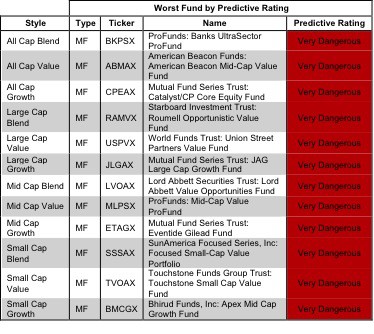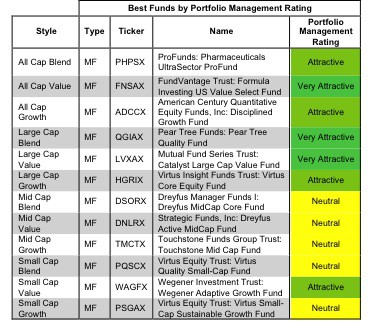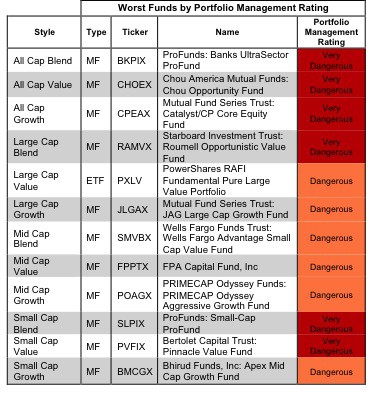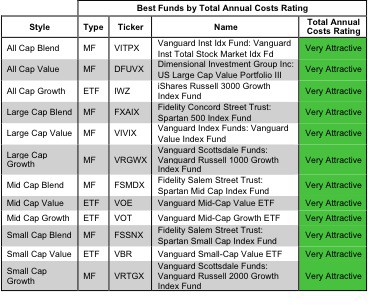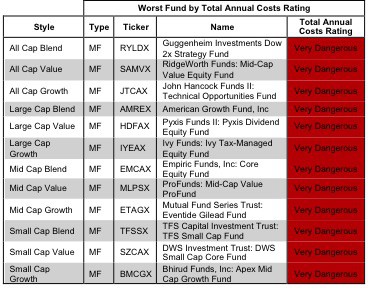This report identifies the “best” ETFs and mutual funds based on the quality of their holdings and their costs. As detailed in “A cheap fund is not always a good fund”, there are few funds that have both good holdings and low costs. While there are lots of cheap funds, there are very few with high-quality holdings.
Without speculating on the cause for this disconnect, I think it is fair to say that there is a severe lack of research into the holdings of mutual funds and ETFs. There should not be such a large gap between the quality of research on stocks and funds, which are simply groups of stocks. Traditional fund research is not as independent as many investors assume.
After all, investors should care more about the quality of a fund’s holdings than its costs because the quality of a fund’s holdings is the single most important factor in determining its future performance.
My Predictive ETF & Mutual Fund Rating system rates 7400+ mutual funds and ETFs according to the quality of their holdings (Portfolio Management Rating) and their costs (Total Annual Costs Rating).
The following is a summary of my top picks and pans for all style ETFs and mutual funds. I will follow this summary with a detailed report on each style, just as I did for each sector.
Figures 1 shows the best ETF or mutual fund in each investment style as of April 23, 2012. There are no attractive funds in any of the Mid Cap and Small Cap styles. No ETFs rank at the top of any of the styles.
For a full list of all ETFs and mutual funds for each investment style ranked from best to worst, see our free ETF and mutual fund screener.
Figure 1: Best Style ETFs and Mutual Funds
Only one style fund gets my Very Attractive rating, GMO Trust: GMO Quality Fund [s: GQLOX]. 29% of this fund is allocated to Very Attractive stocks, including Microsoft [s: MSFT] and Johnson & Johnson [s: JNJ]. Another 36% is allocated to Attractive stocks. About 16% is in Neutral stocks while less than one half of one percent is in Dangerous-or-worse-rated stocks. Now that is a fund manager earning his pay!
One of the fund’s top holding is MSFT. With an ROIC of over 70% and a valuation that implies a permanent 20% decline in profits, MSFT offers compelling risk/reward. The stock is up over 30% since it made my Septemer 2010 Most Attractive stocks list. More details on why I like the stock are here.
Figure 2 shows the worst ETF or mutual fund for each investment style as of April 23, 2012. No ETFs rank as the worst of any of the styles.
Dangerous-or-worse-rated funds have a combination of low-quality portfolios (i.e. they hold too many Dangerous-or-worse rated stocks) and high costs (they charge investors too much for the [lack of] management they provide).
ProFunds: Banks UltraSector ProFund [s: BKPSX] is the worst All Cap Blend fund and gets my Very Dangerous rating. The Portfolio Management and Total Annual Costs ratings for this fund are both Very Dangerous, resulting in a lose-lose value proposition for investors. The managers at BKPSX have a lot of nerve charging an investor over 4% (annualized) for a portfolio of bad stocks.
One of my least favorite stocks in this fund is Bank of America Corp [s: BAC ]. It gets my Very Dangerous rating because of misleading earnings and an expensive valuation. The company’s ROIC is -4%, well below its cost of capital. To justify its valuation, the stock at $8 implies the company will grow its profits at 22% compounded annually for 15 years. Good luck. Read more about why I don’t like the stock here.
Traditional mutual fund research has focused on past performance and low management costs. The quality of a fund’s holdings has been ignored. Our Portfolio Management Rating examines the fund’s holdings in detail and takes into account the fund’s allocation to cash. Our models are created with data from over 40,000 annual reports. This kind of diligence is necessary for understanding just what you are buying when you invest in a mutual fund or an ETF.
Figure 3 shows the best fund based on our Portfolio Management Rating for each investment style as of April 23, 2012.
Attractive-or-better-rated funds own high-quality stocks and hold very little of the fund’s assets in cash – investors looking to hold cash can do so themselves without paying management fees. Only 2% of funds receive our Attractive or Very Attractive ratings, so investors need to be cautious when selecting a mutual fund or ETF – there are thousands of Neutral-or-worse-rated funds.
Figure 3: Style Funds With Highest Quality Holdings
Figure 4 shows the worst fund based on our Portfolio Management Rating for each investment style as of February 2, 2012. Only one ETF ranks as one of the worst style funds: PowerShares RAFI Fundamental Pure Large Value Portfolio [s: PXLV].
The worst fund for each investment style is an actively managed mutual fund; none of the worst investment style funds are passively managed ETFs. Investors pay mutual fund managers to pick stocks for them. Even ignoring costs, mutual fund managers do a poor job investing money for their clients.
Figure 4: Style Funds With Lowest Quality Holdings
Investors should care about all of the fees assocated with a fund in addition to the quality of the fund’s holdings. The best funds have both low costs and quality holdings – and there are plenty of low cost funds available to investors.
Figures 5 shows the best fund in each investment style according to our Total Annual Costs Rating. An ETF ranks as the lowest cost for four of the twelve style cateogries.
Total Annual Costs incorporates all expenses, loads, fees, and transaction costs into a single value that is comparable across all funds. Passively managed ETFs and index mutual funds are generally the cheapest funds.
Figure 5: Style Funds With Lowest Costs
The most expense fund for each investment style has a Very Dangerous Total Annual Costs Rating. Investors should avoid these funds and other funds with a Very Dangerous Total Annual Costs Ratings because they charge investors too much. For every fund with a Very Dangerous Total Annual Costs Rating there is an alternative fund that offers similar exposure and holdings at a lower cost. We cover over 7000 mutual funds and over 400 ETFs. Investors have plenty of alternatives to these over priced funds.
Figures 6 shows the worst fund in each investment style according to our Total Annual Costs Rating. No ETFs ranks as the most expensive for any style category.
Figure 6: Style Funds With Highest Costs
Disclosure: I own MSFT. I receive no compensation to write about any specific stock, sector or theme.


